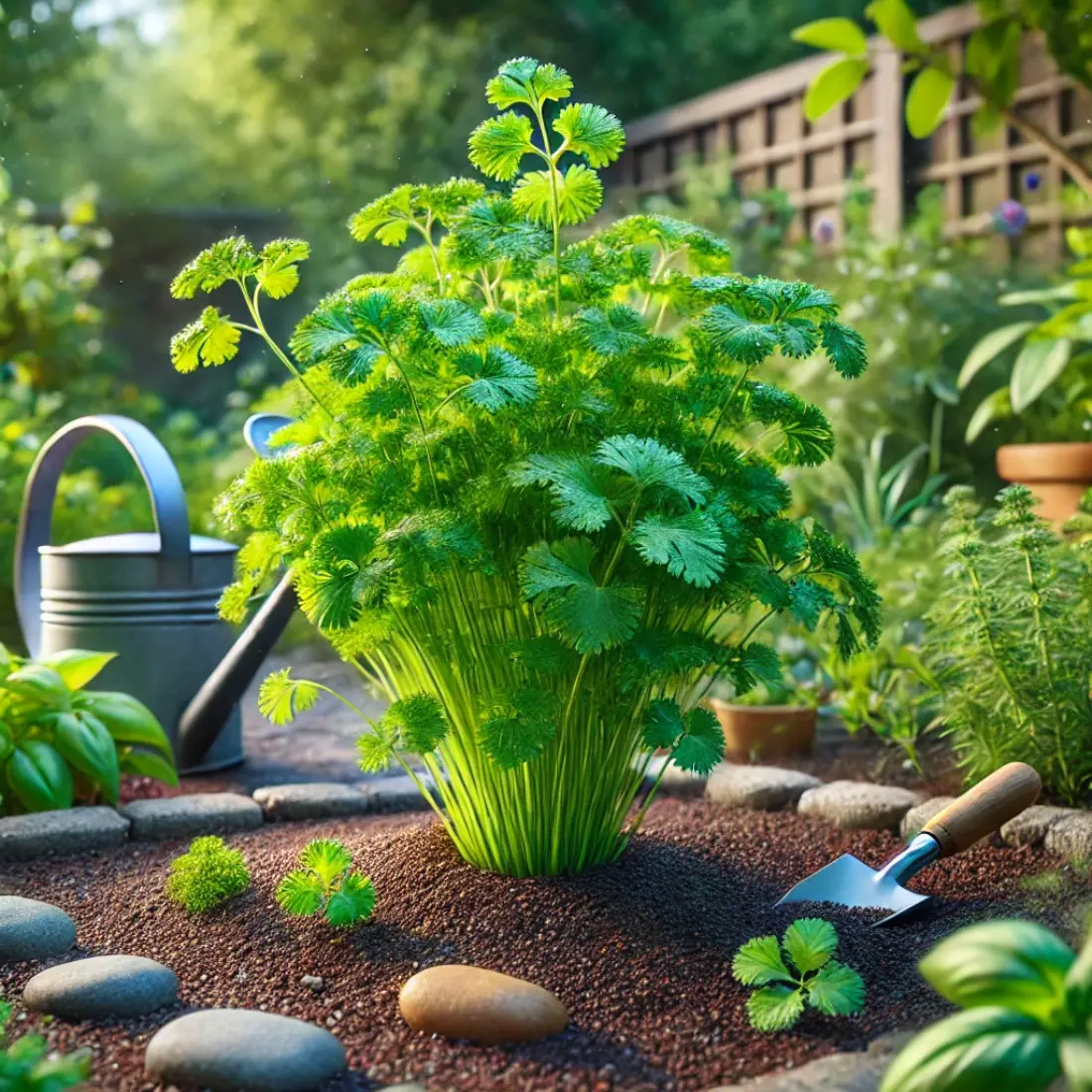Rosemary (Rosmarinus officinalis) is a woody, perennial herb native to the Mediterranean region. Known for its aromatic, needle-like leaves and evergreen nature, rosemary has been used for centuries in culinary, medicinal, and ornamental applications. Its name, derived from the Latin “ros marinus,” means “dew of the sea,” reflecting its natural habitat along coastal cliffs.
Rosemary is highly valued in cooking for its robust, pine-like flavor, enhancing dishes such as roasted meats, potatoes, and breads. Beyond the kitchen, it has been traditionally used for its medicinal properties, believed to improve memory, relieve pain, and boost the immune system. In gardens, rosemary is often planted for its attractive foliage, fragrant scent, and ability to attract pollinators like bees.

Types of Rosemary
There are two main types of rosemary: upright and trailing.
- Upright Varieties: These types grow vertically and are commonly used in herb gardens and as decorative hedges. Popular upright varieties include ‘Tuscan Blue’ and ‘Arp.’
- Trailing Varieties: These types spread out and are perfect for ground cover, hanging baskets, and containers. Notable trailing varieties are ‘Prostratus’ and ‘Irene.’
Choosing the right variety depends on your garden space, climate, and intended use. Upright varieties are ideal for creating structure and height in your garden, while trailing varieties work well for cascading effects and ground coverage.
Growing Rosemary: Step-by-Step Guide
Selecting the Perfect Location
Rosemary thrives in sunny spots with well-draining soil. Ensure your chosen location receives at least six to eight hours of direct sunlight daily. Good air circulation is also important to prevent diseases. If your soil is heavy clay, consider amending it with sand or planting rosemary in raised beds or containers to improve drainage.
Planting Rosemary
Plant rosemary in spring after the last frost has passed. This gives the plant ample time to establish before the growing season.
Planting in the Ground:
- Dig a hole twice the width of the root ball.
- Place the plant in the hole, ensuring the top of the root ball is level with the soil surface.
- Fill the hole with soil, firming it gently around the base.
Planting in Containers:
- Choose a pot with good drainage holes.
- Use a well-draining potting mix, ideally one designed for cacti or succulents.
- Ensure the container is large enough to accommodate the mature size of the plant.
Spacing and Depth:
- Space plants about 2 to 3 feet apart to allow for air circulation.
- Plant at the same depth they were in their nursery pots.
Caring for Your Rosemary Plant
Watering and Feeding:
- Water rosemary sparingly, allowing the soil to dry out between waterings. Overwatering can lead to root rot.
- During the growing season, feed rosemary with a balanced, organic fertilizer once a month.
- Mulching with gravel or small stones can help retain moisture without keeping the soil too wet.
Pruning and Harvesting:
- Prune rosemary regularly to encourage bushy growth and prevent it from becoming woody. Trim about one-third of the plant’s height each spring.
- Harvest leaves as needed, ideally in the morning when the essential oils are most concentrated. Snip sprigs just above a leaf node to promote new growth.
Winter Care
Protecting rosemary during the winter is essential, especially in colder climates:
Outdoor Plants:
- In regions with mild winters, mulch around the base of the plant to insulate roots and reduce temperature fluctuations.
- In areas with harsh winters, cover the plant with a frost cloth or burlap to protect it from freezing temperatures.
Indoor Care:
- Bring potted rosemary indoors before the first frost. Place it in a sunny window that receives at least six hours of sunlight daily.
- Water sparingly, allowing the soil to dry out between waterings, and ensure good air circulation to prevent fungal issues.
Propagation Techniques
Expanding your rosemary garden can be done through seeds or cuttings:
Growing from Seeds:
- Start seeds indoors 10 to 12 weeks before the last frost. Sow seeds in a well-draining seed-starting mix.
- Keep the soil moist and provide warmth and light to encourage germination, which can take 2 to 3 weeks.
Propagation from Cuttings:
- Take a 4-6 inch cutting from a healthy rosemary plant in late spring or early summer.
- Remove the lower leaves and dip the cut end in rooting hormone.
- Plant the cutting in a pot filled with a well-draining potting mix. Keep the soil moist and place the pot in a warm, sunny location.
- Once roots are established (in about 4-6 weeks), transplant the cutting to its permanent location.
- Propagation from cuttings is often quicker and more reliable than growing from seeds, allowing you to expand your rosemary garden efficiently.
Pest and Disease Management
Keeping rosemary healthy involves vigilant pest and disease management:
Common Pests:
- Aphids: Small, green insects that suck plant sap. Remove them by spraying the plant with a strong jet of water or using insecticidal soap.
- Spider Mites: Tiny red or yellow insects that create fine webs on leaves. Control them with regular misting and insecticidal soap.
- Whiteflies: Small, white insects found on the undersides of leaves. Use yellow sticky traps or insecticidal soap to reduce their numbers.
Diseases:
- Powdery Mildew: A fungal disease that appears as white, powdery spots on leaves. Improve air circulation and avoid overhead watering to prevent it.
- Root Rot: Caused by overwatering and poor drainage. Ensure soil is well-draining and allow it to dry out between waterings to prevent root rot.
Common Issues and Solutions
Yellowing Leaves: Often caused by overwatering or poor drainage. Allow the soil to dry out between waterings and improve drainage by adding sand or gravel to the soil mix.
Leggy Growth: Caused by insufficient sunlight. Ensure your rosemary gets at least six to eight hours of direct sunlight daily. Regular pruning also helps maintain compact growth.
Root Rot: Resulting from waterlogged soil. Use well-draining soil and avoid overwatering. If root rot is suspected, remove affected parts and replant in fresh, dry soil.
FAQs about Growing Rosemary
How often should I water my rosemary plant?
Water rosemary sparingly, allowing the soil to dry out between waterings. Typically, watering once a week is sufficient, but this may vary depending on climate and whether the plant is grown indoors or outdoors. Overwatering can lead to root rot, so it’s crucial to ensure good drainage and avoid waterlogged soil.
Can rosemary grow indoors?
Yes, rosemary can be grown indoors. Place the plant in a sunny spot that receives at least six hours of direct sunlight daily. Use a well-draining potting mix and a container with drainage holes. Water sparingly, allowing the soil to dry out between waterings. Good air circulation is also important to prevent fungal diseases.
What are the best companion plants for rosemary?
Rosemary pairs well with other Mediterranean herbs such as thyme, sage, and oregano. It also thrives alongside vegetables like carrots and beans, which benefit from rosemary’s pest-repelling properties. Avoid planting rosemary near plants that require consistently moist soil, as rosemary prefers drier conditions.
How can I prevent my rosemary from becoming woody?
Regular pruning is key to preventing rosemary from becoming woody. Trim about one-third of the plant’s height each spring to encourage new growth. Harvest sprigs regularly, cutting just above a leaf node. Avoid letting the plant flower excessively, as this can contribute to woody growth.
Is rosemary susceptible to any specific pests?
Yes, rosemary can be affected by pests such as aphids, spider mites, and whiteflies. Regularly inspect your plant for signs of these pests, such as yellowing leaves or fine webs. Treat infestations promptly with insecticidal soap or a strong spray of water to keep the pests under control.
How can I use rosemary in cooking?
Rosemary is a versatile herb that enhances the flavor of various dishes. Use fresh or dried leaves to season roasted meats, vegetables, and potatoes. Add sprigs to soups, stews, and sauces for an aromatic boost. Rosemary also pairs well with bread and can be used to infuse oils and vinegars.
What type of soil is best for rosemary?
Rosemary thrives in well-draining soil with a slightly sandy or loamy texture. Avoid heavy clay soils that retain too much moisture. If planting in a container, use a potting mix designed for cacti or succulents to ensure adequate drainage. Adding sand or gravel to garden soil can also improve drainage.
Can I grow rosemary from seeds?
Yes, you can grow rosemary from seeds, but it requires patience as germination can be slow. Start seeds indoors 10 to 12 weeks before the last frost. Sow them in a well-draining seed-starting mix and keep the soil moist. Provide warmth and light to encourage germination, which can take 2 to 3 weeks.
How do I prune my rosemary plant?
Prune rosemary in the spring to encourage bushy growth. Use clean, sharp scissors or pruning shears to trim about one-third of the plant’s height. Focus on removing leggy, woody stems and cutting back to just above a leaf node. Regularly prune and harvest sprigs to maintain a compact, healthy plant.
Can rosemary survive winter outdoors?
In mild climates, rosemary can survive winter outdoors with some protection, such as mulching around the base to insulate the roots. In colder regions, it’s best to bring potted rosemary indoors before the first frost. Alternatively, cover outdoor plants with frost cloth or burlap to shield them from freezing temperatures.










